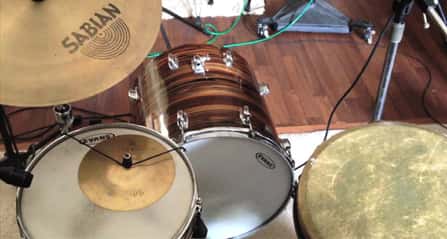
Emotional Dynamics – Adding Passion to Your Sessions
Well, this was supposed to be a video entry. However, the video file was incomprehensibly corrupted somehow and will not open. So much for that. Instead, I’ll just provide the recorded audio examples and you can picture me playing it in your mind. Let’s talk emotional dynamics!
Songs are alive. We mark our lives with them in that the right song can take you back instantly to an event in your past. A good song captures an emotional snapshot and presents it in an artistic fashion. As a session drummer, it is our job to add to that emotion when recording. We should attempt to re-enforce what the song says or communicates.
Is the song frantic? Play hard, aggressive, on top of the beat. Is the song sultry? Play on the backside of the beat and massage the dynamics to differ between sections. To a degree, we should over-exaggerate some of our playing dynamics if it helps to better serve the song. We should exercise a choice in fills that expands on the mental timbre of the song. I call these choices emotional dynamics.
Here’s an example that doesn’t even require backing tracks. Let’s take a half-time groove and play it at the same tempo, transitioning from chorus to verse. We’ll first play the groove angry and then more wistful and introspective. I won’t vary the core elements of the groove, but I will vary where I place the beat in relation to the click, what fills I play, how I ghost between hits, and the general dynamic levels to help enforce the emotion I’m going for.
Playing Angry
First, angry. Note how the sounds are sharp and quick. Ghosting is at a minimum because we want everything we play to make a point. I played a little on top of the beat making the groove feel urgent and aggressive. The fill into the verse is wild and fast to reinforce that churning urgency to be heard.
Playing Relaxed & Introspective
Now, introspective and more relaxed. The groove is the same, but it feels completely different. First, the volume overall is lower. I played a little behind the beat to make things chug along rather than race. I ghost a lot more to add a darker and complex background to the groove. Finally, the fill between chorus and verse is more drawn out, simple and poignant.
Maybe all of this talk about adding emotional dynamics to songs seem laughable, but this kind of attention to a song’s mood can make for a great recording and a very happy client. Of course, there are exceptions. Some modern pop songs require an almost stilted performance with even dynamics and little emotion. Some songs are so bad or cheesy that you just cannot connect with them – that’s the song writer’s fault.
A warning… one could take playing with emotional dynamics too literally and begin to get really abstract (i.e. play more purple!) The concept of emotional dynamics I describe is not about acting or being melodramatic while you are playing. Session musicians can’t win Oscars.
What emotional dynamics are all about in the end is passion. Play with passion. Use that passion to connect to the heart of what the artist is trying to get across. The more you do that, the more you’ll find yourself getting called back.


